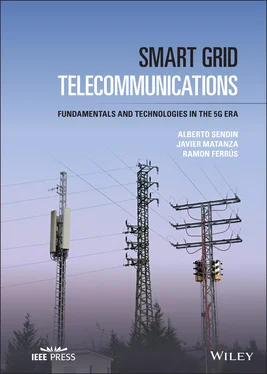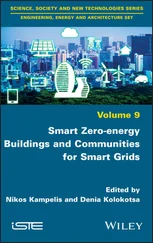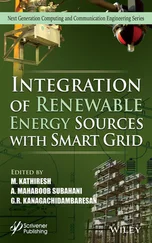Ramon Ferrús - Smart Grid Telecommunications
Здесь есть возможность читать онлайн «Ramon Ferrús - Smart Grid Telecommunications» — ознакомительный отрывок электронной книги совершенно бесплатно, а после прочтения отрывка купить полную версию. В некоторых случаях можно слушать аудио, скачать через торрент в формате fb2 и присутствует краткое содержание. Жанр: unrecognised, на английском языке. Описание произведения, (предисловие) а так же отзывы посетителей доступны на портале библиотеки ЛибКат.
- Название:Smart Grid Telecommunications
- Автор:
- Жанр:
- Год:неизвестен
- ISBN:нет данных
- Рейтинг книги:3 / 5. Голосов: 1
-
Избранное:Добавить в избранное
- Отзывы:
-
Ваша оценка:
- 60
- 1
- 2
- 3
- 4
- 5
Smart Grid Telecommunications: краткое содержание, описание и аннотация
Предлагаем к чтению аннотацию, описание, краткое содержание или предисловие (зависит от того, что написал сам автор книги «Smart Grid Telecommunications»). Если вы не нашли необходимую информацию о книге — напишите в комментариях, мы постараемся отыскать её.
Discover the foundations and main applications of telecommunications to smart grids Smart Grid Telecommunications,
Smart Grid Telecommunications
Smart Grid Telecommunications — читать онлайн ознакомительный отрывок
Ниже представлен текст книги, разбитый по страницам. Система сохранения места последней прочитанной страницы, позволяет с удобством читать онлайн бесплатно книгу «Smart Grid Telecommunications», без необходимости каждый раз заново искать на чём Вы остановились. Поставьте закладку, и сможете в любой момент перейти на страницу, на которой закончили чтение.
Интервал:
Закладка:
Table of Contents
1 Cover
2 Title Page
3 Copyright Page
4 Dedication Page
5 Author Biographies
6 Preface
7 Acronyms
8 1 The Smart Grid1.1 Introduction 1.2 Electric Power Systems 1.3 A Practical Definition of the Smart Grid 1.4 Why Telecommunications Are Instrumental for the Smart Grid 1.5 Challenges of the Smart Grid in Connection with Telecommunications 1.6 Challenges of Telecommunications for Smart Grids References
9 2 Telecommunication Networks and Systems Concepts2.1 Introduction 2.2 Telecommunication Networks, Systems, and Services Definitions 2.3 Telecommunication Model and Services 2.4 Telecommunication Networks 2.5 Protocol Architectures for Telecommunication Networks 2.6 Transmission Media in Telecommunications for Smart Grids 2.7 Electricity Cables References
10 3 Telecommunication Fundamental Concepts3.1 Introduction 3.2 Signals 3.3 Transmission and Reception 3.4 Signal Propagation References
11 4 Transport, Switching, and Routing Technologies4.1 Introduction 4.2 Transport Networks 4.3 Switching and Routing References
12 5 Smart Grid Applications and Services5.1 Introduction 5.2 Smart Grid Applications and Their Telecommunication Needs 5.3 Supervisory Control and Data Acquisition 5.4 Protection 5.5 Distribution Automation 5.6 Substation Automation 5.7 Metering 5.8 Synchrophasors 5.9 Customers 5.10 Power Lines 5.11 Premises and People References
13 6 Optical Fiber and PLC Access Technologies6.1 Introduction 6.2 Optical Fiber Passive Network Technologies 6.3 Power Line Communication Technologies 6.4 Applicability to Smart Grids References
14 7 Wireless Cellular Technologies7.1 Introduction 7.2 Mainstream Technologies and Standards 7.3 System Architecture 7.4 Main Capabilities and Features 7.5 Applicability to Smart Grids References
15 8 Wireless IoT Technologies8.1 Introduction 8.2 Mainstream Wireless IoT Technologies for the Smart Grid 8.3 IEEE 802.15.4‐based Technologies: Zigbee and Wi‐SUN 8.4 Unlicensed Spectrum‐based LPWAN: LoRaWAN and Sigfox 8.5 Cellular IoT: LTE‐M and NB‐IoT 8.6 IoT Application and Management Layer Protocols 8.7 Applicability to Smart Grids References
16 Index
17 End User License Agreement
List of Tables
1 Chapter 1 Table 1.1 Typical components of overhead medium voltage conductors. Table 1.2 Main definitions of the Smart Grid.
2 Chapter 2Table 2.1 ITU‐T optical transmission windows.Table 2.2 Radio frequency ranges as per ITU‐R V.431‐8.Table 2.3 PLC timeline.Table 2.4 Bands and transmission levels defined in EN 50065‐1:2011.
3 Chapter 3Table 3.1 Simulation of receiving one erroneous bit per codeword.Table 3.2 Simulation of receiving two and three erroneous bits per codeword.
4 Chapter 4Table 4.1 Presence of the different technologies in the different domains of ...Table 4.2 TDM technologies data rates.Table 4.3 SDH/SONET technologies data rates (STM optical and electrical; OC f...Table 4.4 OTN interfaces.
5 Chapter 5Table 5.1 Electric Power Distribution Reliability Indices (IEEE 1366‐2012).Table 5.2 IEC 61850 partsTable 5.3 List of Logical Node (LN) groups (IEC 61850‐7‐4).Table 5.4 Transfer time classes.
6 Chapter 6Table 6.1 Main service characteristics of the different PON standards.Table 6.2 Splitter optical power losses.Table 6.3 Data rates for the Communication Modes in PRIME.Table 6.4 Transmission rates in PRIME v1.4 in kbps. N chrepresents the number ...Table 6.5 Number of data carriers used in G3‐PLC.Table 6.6 Maximum bit data rates for G3‐PLC.Table 6.7 Main parameters of IEEE 1901 PHY layer.
7 Chapter 7Table 7.1 Minimum technical performance set for IMT‐2020/5G systems.Table 7.2 IMT bands.Table 7.3 Main frequency bands under consideration for 5G deployment.Table 7.4 LTE operating bands.Table 7.5 Channel bandwidth configurations in LTE.Table 7.6 Comparison between key NR and LTE radio interface features.Table 7.7 NR operating bands in FR2.Table 7.8 Standardized QoS characteristics associated with each 5QI.Table 7.9 Standardized SST values for network slices.
8 Chapter 8Table 8.1 Main wireless IoT technologies for smart grid applications.Table 8.2 IEEE 802.15.4 PHY layer options.Table 8.3 Wi‐SUN PHY layer operating modes.Table 8.4 Sigfox Radio Configurations.Table 8.5 Comparison of the scope of LTE‐M and NB‐IoT technologies.
List of Illustrations
1 Chapter 1 Figure 1.1 Electricity at the core of critical services. Dependencies are ba... Figure 1.2 Building blocks of traditional electric power systems. Figure 1.3 Medium voltage common topologies. Figure 1.4 Low voltage common topologies. Figure 1.5 Primary substation examples. Figure 1.6 Different types of secondary substations. Figure 1.7 Sample weekly aggregated electricity demand curve. Consumption in...
2 Chapter 2 Figure 2.1 Generic telecommunications model. Figure 2.2 Digital telecommunications in an analog world. Figure 2.4 Network topology types. Figure 2.3 Telecommunications and power systems architecture conceptual orga... Figure 2.5 Transport and Switching/Routing are complementary. Figure 2.6 Traffic efficiency in circuit or packet‐based networks. Figure 2.7 Circuit‐switched network. Figure 2.8 Packet‐switched network. Figure 2.9 Multiple layers in telecommunication networks. Figure 2.10 Representation of the OSI layered model. Figure 2.11 Relationship between OSI and TCP/IP layer functionalities. Figure 2.12 Data structures in the TCP/IP layered model.Figure 2.13 Optical fiber cables.Figure 2.14 Structure to coordinate radio spectrum use.Figure 2.15 Some examples of cable dispositions in power lines (MV to the le...
3 Chapter 3Figure 3.1 (a) Examples of continuous‐time signals (left) and discrete‐time ...Figure 3.2 Sampling and quantizing process. Quantization error.Figure 3.3 Analog (left) and digital (right) signals.Figure 3.4 Time and frequency representation of a sinusoidal signal. Upper: ...Figure 3.5 Time and frequency representation of a finite‐domain sinusoidal s...Figure 3.6 Time and frequency representation of a sum of sinusoids (top) and...Figure 3.7 Time (left) and frequency (right) representation of a 1250 Hz win...Figure 3.8 Block diagram of a typical digital communications system.Figure 3.9 Double Sideband modulated and information signals in time and fre...Figure 3.10 Constellation for different Phase Shift Keying digital modulatio...Figure 3.11 4‐PSK, 8‐PSK, and 16‐PSK constellations. Transmitted symbols (ci...Figure 3.12 Example of a channel's frequency response.Figure 3.13 Communication performance in terms of BER/SNR for 4‐PSK, 8‐PSK, ...Figure 3.14 Orthogonal frequency representation.Figure 3.15 Schematic representation of an OFDM transmitter block.Figure 3.16 Example of how an interleaver scatters burst errors in communica...Figure 3.17 Representation of the hidden node problem in a wireless scenario...Figure 3.18 Main propagation phenomena in optical fiber.Figure 3.19 Propagation phenomena.Figure 3.20 Link budget example calculation.
4 Chapter 4Figure 4.1 Increasing capacity achievement.Figure 4.2 PDH link.Figure 4.3 SDH/SONET transport network.Figure 4.4 WDM link.Figure 4.5 Common use of bridges to interconnect three LANs.Figure 4.6 Interconnection of hosts and possible paths.Figure 4.7 Network with inter and intra‐autonomous system links.Figure 4.8 Ethernet packet.
5 Chapter 5Figure 5.1 Utility applications.Figure 5.2 The relationship among utility management systems, automation dom...Figure 5.3 Application Protocol Data Unit (APDU) in IEC 60870‐5‐104 protocol...Figure 5.4 Basic protection representation of a feeder.Figure 5.5 Teleprotection concept.Figure 5.6 Distribution automation example in a ring protection.Figure 5.7 Intra‐substation IEC 61850 components.Figure 5.8 AMI common architectures.Figure 5.9 Phasor Measurement Units (PMUs) and Phasor Data Concentrators (PD...Figure 5.10 Daily demand curve modification to reduce peak consumption.
Читать дальшеИнтервал:
Закладка:
Похожие книги на «Smart Grid Telecommunications»
Представляем Вашему вниманию похожие книги на «Smart Grid Telecommunications» списком для выбора. Мы отобрали схожую по названию и смыслу литературу в надежде предоставить читателям больше вариантов отыскать новые, интересные, ещё непрочитанные произведения.
Обсуждение, отзывы о книге «Smart Grid Telecommunications» и просто собственные мнения читателей. Оставьте ваши комментарии, напишите, что Вы думаете о произведении, его смысле или главных героях. Укажите что конкретно понравилось, а что нет, и почему Вы так считаете.












